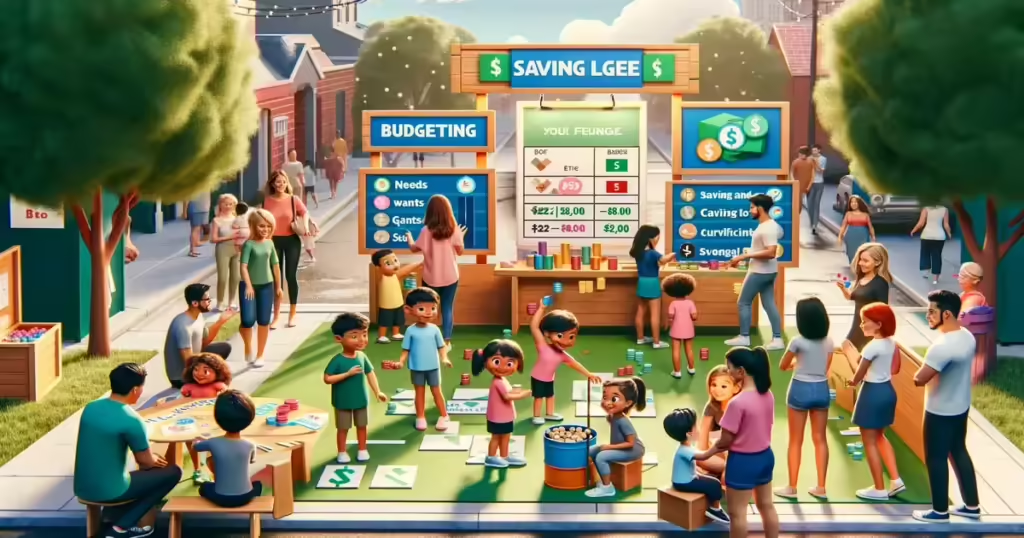Ultimate Guide: Teaching Kids Financial Literacy for a Bright Future

In today’s complex financial world, being money savvy is one of the most essential life skills. Yet studies show that financial illiteracy is a widespread issue, leading to crippling debt, unpreparedness for emergencies, and inability to save for retirement. The lack of personal finance knowledge often starts from a young age – which is why teaching kids financial literacy should be a top priority for parents.
Financial literacy empowers children to develop healthy money habits and mindsets from an early age. With a solid grasp of budgeting, saving, investing, and more, kids grow into financially responsible adults capable of achieving their goals and dreams.
On the other hand, those who don’t receive a financial education are more likely to struggle with money management and make poor choices that jeopardize their future financial security.
Fundamentals to Teach Kids About Money
To set kids up for financial success, there are several key money concepts they need to understand:
Budgeting Basics – Explain the fundamentals of budgeting, including identifying income sources, tracking expenses, differentiating needs vs wants, and allocating funds towards saving goals. Make a game of categorizing transactions and staying within a set budget.
Banking & Investing – Introduce banking basics like interest, deposits, withdrawals and the importance of saving. For older kids, explain investment vehicles like stocks, mutual funds and retirement accounts. Use examples and hands-on tools to illustrate how money can grow over time.
Debt & Credit – Discuss what debt is, how it accumulates from overspending, and the consequences of not paying it back (fees, interest charges, damaged credit score). Emphasize the responsible use of credit cards and loans.
While the complexity level will depend on the child’s age, the sooner these fundamentals are instilled, the more naturally good financial habits will develop. Make learning engaging and relevant to their current life experiences.
Age-Appropriate Money Lessons
It’s never too early to start teaching kids about money! Here are some age-appropriate financial lessons to cover:
For Preschoolers & Elementary Kids – Use cash, coins, and games to explain basic money concepts like earning, spending, and saving. Please set up a simple bank/wallet for them to practice with. Read children’s books that introduce financial vocabulary. Take them on shopping trips to practice identifying costs and making choices within a set budget.
For Middle Schoolers – Align lessons with their growing autonomy and desire for material things. Discuss money-earning opportunities like chores, small jobs, or entrepreneurial ventures. Involve them in basic money management tasks like paying bills, reconciling accounts, comparison shopping, and sticking to a budget. Explain lending and credit card fundamentals.
For High School Teenagers – Dive deeper into budgeting methods, investment products, loans, mortgages, taxes, and long-term financial planning. Encourage checking and savings accounts in their name. Let them make some spending mistakes in a controlled environment to learn from experience. Discuss financial aid, funding college, and future income/career expectations.
Tailor the specific topics and activities to each child’s maturity level and interests. The key is making financial education an ongoing process that evolves as it grows!
Creative Ways to Make Money Lessons Fun
While financial literacy involves some dry theoretical components, it doesn’t have to be all lectures and textbooks. Getting creative and hands-on with money lessons makes the subject much more engaging and memorable for kids. Try out:
Games & Activities
Hands-On Experiences
Learning by Example
The more interactive and tangible money lessons are, the better kids will understand and retain the core financial principles at play.

Parents’ Role in Financial Literacy
While financial educators stress the importance of lifelong money management skills, parents are truly a child’s first and most influential financial literacy teachers. Here’s how you can embrace that role:
Having Open Money Conversations – Normalize talking about finances by regularly discussing money matters with your kids in an age-appropriate way. Answer their questions thoroughly and don’t avoid tricky topics like debt or financial mistakes you’ve experienced. An open dialogue helps kids feel more comfortable managing their own money later.
Setting Up Learning Opportunities – Look for teachable moments to cover financial concepts, whether through current events, family scenarios, or their own spending experiences. Involve them in real-life situations like budgeting for vacations, planning major purchases, applying for loans, and filing taxes. The practical applications will make the lessons click.
Modeling Good Financial Habits – Kids undoubtedly pick up many of their money attitudes and behaviors by observing their parents. So be mindful of exhibiting positive habits around budgeting, saving, spending restraint, negotiating, etc. Your actions speak volumes.
With your active guidance and involvement, youth can develop a healthy relationship with money and gain the confidence to make smart financial decisions down the line.
Celebrating Financial Literacy Month
Did you know that April is officially Financial Literacy Month in the United States? This nationally recognized period aims to highlight the importance of establishing strong economic and money management skills.
While financial literacy should be prioritized year-round, this month provides the perfect opportunity to raise awareness and commit to equipping the younger generation with quality financial education. Here are some ideas to get your kids engaged:
Discuss the Significance – Explain why being money-smart matters for achieving personal life goals and economic prosperity as a whole. Share statistics on the risks and costs of remaining financially illiterate. Tap into their sense of motivation.
Participate in Activities – Many banks, schools, and community groups host special financial literacy activities, classes, and contests during April. Get your family involved through online webinars, in-person workshops, games, and more. Make it a fun learning experience!
Set New Money Goals – Use this month as a catalyst to implement new financial habits at home. Work together to create a family budget, identify areas to cut back on spending, set savings targets, and establish a money rewards system for completed tasks/chores. Small steps culminate in big changes over time.
Celebrate Progress – Throughout the month, acknowledge financial literacy milestones and positive behaviors you notice. Provide encouragement and recognition for your kids’ efforts to learn about money management. End April with a special activity reinforcing what they’ve learned.
Financial Literacy Month serves as an important reminder to invest in our kids’ financial know-how continually. With dedication, they’ll develop skills to manage their money wisely.
Resources for Financial Education
To further support your efforts to build financial literacy in kids, tap into the multitude of helpful resources available:
Books & Curricula
Online Tools & Apps
Local Organizations
By utilizing these resources in tandem with your active teaching, kids can develop a truly comprehensive base of financial knowledge from multiple angles. Equip them with the proper training, and they’ll be prepared to navigate all money matters, big or small confidently.






